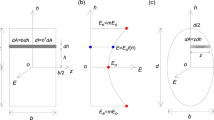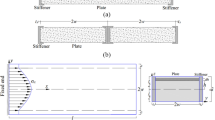Abstract
The flexure of cantilevers is one of the early problems, if not the first, to have been studied by the elasticity theoreticians. One considers axisymmetrical rods and rectangular section beams. This investigation concerns the case where the maximum stress is constant (Galilei-Euler-Clebsch problem) as well as the case where the curvature of the medium fiber is constant. For both cases, it is shown that the equations to solve belong to the same class. The research was into thickness distributions replying to those conditions under various loading cases.
At the free end, the distributions obtained degenerate into a family for which the thickness is null, but contrary to a widely held opinion, they also and naturally give forms showing a finite thickness at this end. The proposed distributions have a general form which has not been found in the literature treating elasticity theory or strength of materials [1-9]. They are extensions of Euler and Clebsch formulas.
Similar content being viewed by others
References
Galilei Galileo, Discorsi e Dimostrationi Matematica, Leiden, 1638.
Euler, L., Mémoires de l'Académie des Sciences de Berlin, T. XIII, 1758.
Clebsch, Alfred R.F., Theorie der Elasticität fester Körper, Leipzig, 1862 (French translation by Saint-Venant and Flamant).
Barré de Saint-Venant Adhémar, Appendices to Résumé des Leçons (de Navier) sur l'Application de la Mécanique, Paris, 1864.
Barré de Saint-Venant Adhémar, Annoted version of its French translation of the Clebsch book, Théorie de l'Elasticité des Corps Solides, Paris, 1883, frequently referenced as Clebsch Annotée(cf Love, pp. 489).
Todhunter, Isaac and Pearson, Karl, A History of the Theory of Elasticity and of the Strength of Materials, Dover, New York, (I) 1886 and (II) 1893.
Love, A.E.H., A Treatise on the Mathematical Theory of Elasticity, Dover, New York, 1927.
Timoshenko, Stephen P., Strength of Materials, Van Nostrand, Princeton, NJ, 1952 pp. 201.
Timoshenko, Stephen P., History of Strength of Materials, Dover, New York, 1953 (Galilei, pp. 12–14 and Euler, pp. 33–34).
Forsyth, A.R., A Treatise on Differential Equations, Macmillan, London, (1958), 88.
Lemaître, G.R., ‘Miroirs à courbure variable’, Comptes Rendus Acad. Sco., 276-B(1973) 145 and 282-B (1976) 87.
Lemaître, G.R., ‘Compensation des aberrations par élasticité’, Nouvelle Revue d'Optique, 5(6) (1974) 361.
13. Lemaître, G.R., ‘Active mirrors and elasticity’, Astron. Astrophys. 285(1994) 344.
Ferrari, M., ‘Analysis of a large deflection variable curvature mirror’, Astron. Astrophys. 274(1993) 12.
Ferrari, ‘Optique active et Miroirs à courbure variable’, Doctoral Dissertation, Université Aix-Marseille I, (1994).
Author information
Authors and Affiliations
Rights and permissions
About this article
Cite this article
Lemaitre, G.R. Equal Curvature and Equal Constraint Cantilevers: Extensions of Euler and Clebsch Formulas. Meccanica 32, 493–503 (1997). https://doi.org/10.1023/A:1004278131928
Issue Date:
DOI: https://doi.org/10.1023/A:1004278131928




